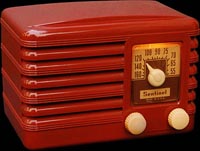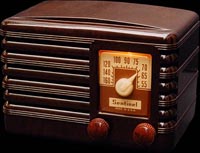
Sentinel model 309-W
ca. 1947
The "before" picture ...

Painted bakelite, 5 1/2" high, 8" wide, and 4 1/2" deep (without the knobs)
Tube Lineup Osc., Mod., Converter 12BE6 IF Amp 12BA6 Detector, AVC, AF 12AT6 Audio Power Amp 50B5 Rectifier 35W4 IF = 455kHz This was an eBay purchase, described as a
nice small kitchen radio..looks like some one repainted it about 10-15 years ago..it is in very good working orderWell, it may have been, but the person who got the mail that day was carrying it under their arm, and fell off their bicycle on the way home. When I opened it and started peeling of the tape from the bubble-pack, I promptly got a sliver of glass in my finger, which turned out to be part of either the 35W4 rectifier tube, or the 12BE6 converter tube, the larger remains of which were bouncing around inside the cabinet. I didn't give him a hard time about it because he lost a patch of skin from his hand.The cabinet design is starting to appeal to me more as I look at it. It makes me think it belongs on the set of a Tennessee Williams play, or in a starving artist's third-floor walk-up apartment.
I'm guessing at the model number. It has "MODEL 309" stamped on the chassis, but the sticker on the bottom got sprayed over by a previous owner. I first thought it was off-white paint brushed on over a factory applied enamel, but then I noticed that some areas on the bottom had dark brown bakelite showing through the spray. Also, none of the flakes that came off had anything other than the top coat colour under them. Later I looked at the painted-over label with a magnifying glass under strong side lighting. This made some of the printing show up faintly in relief, and as near as I can tell, it has a "W" after the model number. This would mean that the original colour was "Walnut", which I suppose is simply the bare bakelite with some texture in it.The other model numbers are 309-I for ivory, 309-R for red plaskon, and 309-N for I-don't-know-what.
I gave it a quick once-over under the chassis, inserted two spare tubes from a parts radio, and fired it up, using my handy-dandy dim-bulb tester. Nothing. No singing, no humming, no light from the filaments, dim-bulb or pilot lamp. It was DOA. After disconnecting I turned it over and found a lot of long un-insulated leads of replacement caps, and quite a few questionable solder joints, including one that was to a tube base terminal that had broken off completely. I was too tired that night to pursue it further, but I'm hoping that it's from one of the series-connected tube filaments, and repairing that might at least get something to light up.
The loop antenna glued to the masonite back is a bit unusual. I must put up some scans of it later.
I was planning to strip the cabinet and paint it some original colour scheme. If the bare cabinet isn't too scarred, I may just polish up the bakelite, since it was a "walnut" model. I really don't know what to make of the painted powder blue knobs. They look like they're brown bakelite under the paint. (Actually, I had been considering a light blue and chocolate brown colour scheme at one point.) Their paint job looked so much better than the cabinet's that I began to wonder if it was a factory job. (The mysterious "N" colour perhaps?) Now that I've seen John Pelham's 309s, (see below) I may just strip off the blue and polish them up as well.
More good news - the dial face, transparent plastic cover, and pointer are in great condition, with barely noticeable UV light damage to the face.
September 4, 2000
Nope - that broken terminal turned out to belong to the plate of the audio output amp.
Other Sentinel 309s:

Sentinel 309-R (red plaskon)
Sentinal model 309-WAs seen on John Pelham's Collection of Antique Radios and Other Old Things. You can get the Service data and Schematic from the Nostalgia Air online collection of Rider service manuals, although they can be somewhat difficult to read in places.
March 1, 2001
Bad News:
New rule: Do not leave knobs in strong stripper and then start watching a movie on TV.
I did just that, and returned to find a container with two blobs of brown and powder-blue jelly. Until I find some more that resemble the originals, I'm thinking of taking a pair of generic knobs, filing the skirt off the bottoms, and painting them an ivory colour.Good News:
I was able to get the label a bit more legible, using a bit of paper towel dampened with Goof-Off to soften the paint, and then scraping the paint off with an X-Acto knife, under a 10-power magnifier. Later, the label had accidently gotten wet (with water) and I was able to peel it off in one piece, which allowed me to be a bit more aggressive in removing the paint from the cabinet.I was able to polish out all of the scrapes and scratches on the cabinet, (using 400 grit sandpaper, crocus cloth, and then automotive polishing compound) and I've decided not to paint it. It is, after all, a model "309-W"
I took everything off the top of the chassis (except for the IF cans) and gave it a good cleaning, with waterless hand cleaner, a toothbrush, a Scotchbrite pad, and a final water rinse. I also hit it with a blast from a 100 psi compressed air hose nozzle to help speed up the drying.
I found a spare tube socket and replaced the broken one for the 50B5, but it's white ceramic and doesn't look right next to the phenolic ones. I'll wait until I get a better match before I proceed with the recapping.
Over to John Rose's Vintage Radio Home